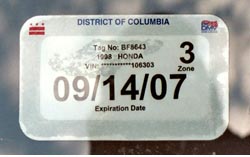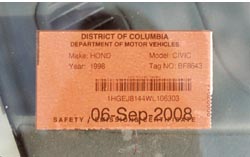Miscellaneous D.C. Plate Topics
| Subjects addressed on this page are: | |
| License Plate Displays |
Error Plates
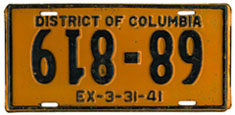
Some of the most interesting plates for collectors to locate are those that were manufactured (and occasionally issued) with some type of noticeable flaw. Four of the examples pictured are inverted errors and the other two have a registration error, registration in this context referring to the alignment of plate blanks in the machine in which they were cut or embossed.
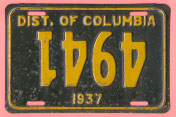 |
 |
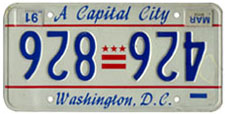 |
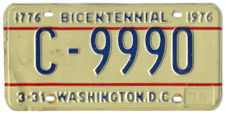 |
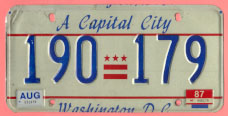 |
Registering a Vehicle in Washington D.C.
The District of Columbia Dept. of Motor Vehicles is responsible for issuing and keeping track of vehicle registrations. Its main office is located at 301 C St. NW. Before any vehicle can be registered it must pass inspection and be titled. Vehicles with valid plates from another jurisdiction may be inspected with them, whereas cars with expired plates (from D.C. or elsewhere) must be registered with a D.C. 30-day temporary plate in order to be taken to the inspection station. Upon passing inspection, the vehicle's owner proceeds to a DMV customer service center with a title application, valid identification, proof of vehicle ownership and D.C. insurance, odometer certification statement, and the appropriate fee(s). Lease and lien documents are also required, if appropriate.
For recordkeeping purposes the DMV segregates vehicles into six classes:
- Class A: Non-commercial passenger vehicle
- Class B: Commercial vehicle, tractor, and passenger-carrying vehicle for hire having a capacity of at least 8 passengers
- Class C: Trailer
- Class D: Motorcycle
- Class E: Motorized Bicycle (moped)
- Class F: Historic Motor Vehicle
There are presently two levels of annual passenger vehicle registration fee: $72 for vehicles that weigh less than 3,500 lbs., $115 for heavier vehicles. These fees, which are doubled for motorists that request the optional two-year registration, went into effect on March 6, 2003. They represent a 30% increase over the previous fees. Weight-based registration fees for trailers range from $20 to $431 annually. For motorcycles and mopeds, the annual fee is $30 and $10, respectively.
D.C. plates of all types may not be transferred from one individual to another with the sole exception of personalized plates, which may be transferred only to a surviving spouse, from joint ownership of a vehicle to sole ownership, or from sole to joint ownership.
Non-residents may maintain and operate vehicles properly registered elsewhere within the District for a period not to exceed 30 continuous days. To keep a non-D.C.-registered vehicle in the District for more than 30 days, a D.C. registration must be purchased unless the motorist purchases a reciprocity sticker. This allows the vehicle to remain in D.C. for an additional 180 days. Only a single 180-day sticker may be purchased by a non-resident during a calendar year. Fees for these stickers are $25 if the vehicle is not kept in the District and $125 if it is.
 |
|
It takes more than a pair of license plates to prove that a vehicle is properly registered in the District of Columbia. Examples of the three required devices, all attached to a 1998 Honda Civic, are shown here. Most evident, of course, is the set of plates, but two windshield stickers are also displayed. At the upper right is the registration sticker, which in this case shows an expiration date of Sept. 14, 2007. It is displayed in the lower left corner of the windshield, and the "Zone 3" notation indicates the portion of the city in which the vehicle is permitted to be parked. The purpose of the orange sticker, displayed in the lower right corner of the windshield, is indicated by SAFETY/EMISSIONS CERTIFICATE printed across the bottom. Note that both stickers include the matching registration (license plate) number and all or at least a portion of the vehicle identification number. |
Registration Reciprocity
Until 1924, Washington residents that wished to operate their D.C.-registered vehicles in Maryland had to register them there and display license plates of both jurisdictions. Similarly, Maryland residents that ventured into the District also had to have both Maryland and D.C. plates on their cars. Click here to reach our page dedicated to this subject.
D.C. Vehicle Registration Statistics
To license plate collectors, one of the most intriguing aspects of Washington, D.C. plates is their scarcity as compared to plates from the states. This scarcity is a result of the relatively small number of plates made and issued, which, in turn, is a function of D.C.'s population and the number of vehicles owned by residents. As a city with public transportation and limited parking, many of the District's 572,000 residents cannot or choose not to own a vehicle.
Although there is undoubtedly a correlation between the number of reported registered vehicles within and the number of plates from a particular jurisdiction, an analysis to identify that relationship is beyond the scope of this resource. However, suffice it to say that the number of registrations reported in a single period (most commonly a single calendar year) is not the number of plates made and issued. D.C. plates of most types are issued in pairs, so there are actually two plates for every registered vehicle, but all reported registrations are not valid at any single point in time.
Therefore, although registration statistics are not a reliable indicator as to how many plates exist from a particular jurisdiction for a certain year, they do provide a good basis for determining the relative scarcity of plates of various jurisdictions, as well as for comparing the scarcity of various plate and registration types of one jurisdiction. It is for these purposes that the data below has been presented. Unless noted otherwise, its source is the U.S. Dept. of Transportation, Federal Highway Administration.
2003 Motor Vehicle Registrations, U.S. and Five Highest and Lowest Jurisdictions
|
Automobiles |
Trucks |
Motorcycles |
Buses |
Total |
Percent |
|
Total U.S. |
135,669,897 |
94,943,551 |
5,328,300 |
776,550 |
236,718,298 |
100.0% |
California |
18,699,434 |
11,496,248 |
546,684 |
52,387 |
30,794,753 |
13.0% |
Texas |
7,841,637 |
6,962,883 |
258,253 |
84,260 |
15,147,033 |
6.4% |
Florida |
8,564,237 |
5,915,175 |
386,381 |
46,713 |
14,912,506 |
6.3% |
New York |
8,313,058 |
2,427,652 |
149,951 |
60,991 |
10,951,652 |
4.6% |
Ohio |
6,518,579 |
3,977,279 |
285,376 |
40,514 |
10,821,748 |
4.6% |
|
419,150 |
265,594 |
14,971 |
2,073 |
701,788 |
0.3% |
Alaska |
260,999 |
373,478 |
19,612 |
2,306 |
656,395 |
0.3% |
Wyoming |
231,895 |
385,053 |
27,744 |
2,916 |
647,608 |
0.3% |
Vermont |
271,819 |
242,122 |
26,332 |
2,130 |
542,403 |
0.2% |
Wash., D.C. |
184,199 |
41,363 |
1,188 |
2,789 |
229,539 |
0.1% |
The number of D.C. vehicle registrations decreased by 12.3% between 1992 and 2003. Here are the 1992 statistics:
1992 Washington, D.C. Motor Vehicle Registrations
|
Automobiles |
Trucks |
Motorcycles |
Buses |
Total |
|
Wash., D.C. |
237,619 |
16,018 |
1,398 |
2,769 |
257,804 |
Washington, D.C. has a much higher percentage of buses than other U.S. jurisdictions due to the concentration of sightseeing buses that cater to millions of tourists annually. In 2003, buses comprised 1.2% of all registered D.C. vehicles as compared to only 0.3% nationally. In 1992, 2,271 of the 2,769 buses registered in D.C. were privately-owned for commercial (non-school) uses, ranking it 16th in the nation for commercial bus registrations even though overall the District has, in recent years, consistently ranked number 51 in the list of states and D.C. ranked by number of registered vehicles.
Over the 50-year period ending in 2000, Washington D.C. lost 28.7% of its 802,000 residents of 1950. Despite the long-term exodus from D.C., the number of vehicles has increased. Back in 1950, four of the 48 states had fewer registered vehicles than D.C. as indicated in this data from The World Almanac and Book of Facts for 1950:
1950 Registered Automobiles, Buses, and Trucks,
U.S. and Five Highest and Lowest Jurisdictions
Vehicles |
Percent of Total |
|
Vehicles |
Percent of Total |
||
Total U.S. |
58,589,863 |
100.0% |
||||
California |
5,698,842 |
9.7% |
Wash., D.C. |
195,563 |
0.3% |
|
New York |
4,392,875 |
7.5% |
Wyoming |
168,487 |
0.3% |
|
Pennsylvania |
3,553,981 |
6.1% |
Delaware |
139,726 |
0.2% |
|
Texas |
3,506,599 |
6.0% |
Vermont |
131,287 |
0.2% |
|
Ohio |
3,300,486 |
5.6% |
Nevada |
115,182 |
0.2% |
Number of New Registrations and License Plates Issued
During Fiscal Year 2011: Oct. 1, 2010-Sept. 30, 2011
This data appeared on a blog entitled On Foot in late February 2012. As published, it included 28,674 non-plate transactions (such as the issuance of inspection stickers, as well as placards for various purposes), so although it reported that “The D.C. Department of Motor Vehicles issued 113,259 tags to District drivers in the fiscal year of 2011,” in fact we believe that only 84,585 plates (in pairs or as singles) were issued. Note also that this includes only new transactions, which is to say this is not a complete list of types and quantities in use as of any particular date. For example, a number of organizational plates are not listed, presumably because none were issued during the fiscal year. On Foot indicates that this data was released by the DMV “in responses to the D.C. Council from earlier this month.”
We have grouped this data in our own categories and modified certain type names to conform to how they are presented elsewhere on this site. For example, we changed “AT SU ALUMNI TAGS” in the original list to “N.C. A&T State Univ. Alumni.” As for their order, within the third and fourth categories we have grouped plates of certain themes and listed them in descending order by issuance quantities. In the optional restricted (organizational) plate category we have first listed college and university plates, then fraternity and sorority plates, then other organizational designs. Within the non-passenger category we have begun with plates issued to private owners, then temporary plates, then plates for government-owned vehicles, then other types.
|
Plate Type |
Quantity |
|
Private - unrestricted |
||
| General-Issue Passenger |
52,257
|
|
Private - optional unrestricted |
||
www.washingtondc.gov legend |
555
|
|
Anacostia River Commemorative |
309
|
|
|
sub-total, optional unrestricted |
864
|
Private - optional restricted (i.e. organizational) |
||
| University of Michigan | 8 |
|
| George Washington University | 2 |
|
| N.C. A&T State Univ. Alumni | 2 |
|
| Florida A&M University | 1 |
|
| Morehouse College Alumni | 1 |
|
| St. John's College | 1 |
|
| Alpha Phi Alpha Fraternity | 4 |
|
| Kappa Alpha Psi Fraternity | 4 |
|
| Alpha Kappa Alpha Sorority | 2 |
|
| Omega Psi Phi Fraternity | 2 |
|
| Delta Sigma Theta Sorority | 1 |
|
| Fraternal Order of Police | 30 |
|
| D.C. Firefighters Local 36 | 25 |
|
| Disabled American Veteran | 9 |
|
| Porsche Club of America | 8 |
|
| Bad Boys Club | 1 |
|
| Veterans of Foreign Wars | 1 |
|
| Nat'l Assn. of Black Scuba Divers | 1 |
|
| Prince Hall Masonic Family | 1 |
|
sub-total, organizational plates |
104 |
|
Non-Passenger |
||
| Motorcycle | 1,231 |
|
| Personalized | 688 |
|
| Disabled Person | 245 |
|
| Historic Motor Vehicle | 132 |
|
| Disabled Veteran | 8 |
|
| Clergy | 6 |
|
| Medical Doctor | 1 |
|
| Temporary - DMV-issued | 23,109 |
|
| Temporary - dealer-issued | 1,099 |
|
| Temporary - motorcycle | 223 |
|
| D.C. Government | 746 |
|
| D.C. Government Motorcycle | 23 |
|
| Taxi | 1,062 |
|
Rental |
819 |
|
Commercial |
695 |
|
| Bus | 594 |
|
| Dealer | 413 |
|
| Trailer | 199 |
|
| Livery/Limousine | 51 |
|
| Transport | 16 |
|
sub-total, non-passenger plates |
31,360 |
|
Total new-plate-issue transactions |
84,585 |
|
What are our impressions of this data? First, we are glad to see that the number of general-issue passenger plates issued during this non-calendar-year, twelve-month period is close to our estimate of the number of plates assigned during calendar years 2010 (we estimated 53,800) and 2011 (50,600), as shown here. Also:
- We know that some types are seldom issued, but it seems unrealistic to conclude, based upon this list, that not a single Apportioned, Personalized Motorcycle, or Manufacturer plate was issued during a twelve-month period. As for Motorcycle Dealer, Solid Waste, and Foreign Organization? Well, their absence from this list isn't too surprising. In fact, we wonder whether Solid Waste plates are still offered and whether any are still in use.
- Where is the Water and Sewer Authority? To include it in D.C. Government (if in fact it was) would be inappropriate because it has special plates simply because it is an authority, technically not a part of the city government, but rather a quasi-public body. It is difficult to believe that WASA didn't need any license plates in fiscal year 2011.
- We're surprised to see that a Medical Doctor plate was issued last year because we believed that they were no longer available. The same goes for Clergy, for that matter.
- George Washington University, Veterans of Foreign Wars, and Disabled Veteran plates are being issued but we still have never seen an example of any of them. In fact, we don't know to what type "Disabled Veteran" refers. Is it the D.C. Veteran optional plate, the handicapped style of Disabled American Veteran organizational plate, or something else?
- We're a little surprised to not see a generic, catch-all category (labeled something such as "Miscellaneous") in which special plates such as those provided to elected officials would be included. It's unrealistic to believe that not a single one was issued in a year.
- It's amazing that there is a jurisdiction, anywhere, that registers more than four times more rental cars than trailers. Only in the Nation's Capital!
Security Marks
 A security mark is an identifying image imprinted in the reflective sheeting used in the manufacture of most (and perhaps all) Washington, D.C. license plates since 1986. The product name of the security mark is Ensure Image, and it's a part of the sheeting added by its manufacturer, 3M Corporation. All D.C. security marks are round and appear in a repeating pattern down the center of the plate. The dark 1.25" diameter marks can be seen clearly only when the plate is viewed at a 30 degree angle, and are placed in the sheeting for control purposes during the production process and as a security measure against counterfeiting.
A security mark is an identifying image imprinted in the reflective sheeting used in the manufacture of most (and perhaps all) Washington, D.C. license plates since 1986. The product name of the security mark is Ensure Image, and it's a part of the sheeting added by its manufacturer, 3M Corporation. All D.C. security marks are round and appear in a repeating pattern down the center of the plate. The dark 1.25" diameter marks can be seen clearly only when the plate is viewed at a 30 degree angle, and are placed in the sheeting for control purposes during the production process and as a security measure against counterfeiting.
The earliest D.C. security marks resemble the graphic reproduction of a later mark shown above, but include a two-digit year designation in place of the four-character code pictured. The earliest observed mark is dated "86", and dated "87," "88," "89," and "90" marks were also used before the year designation was replaced by the four-character code.
Replacement of the year designation with a four-character production date code appears to have occurred simultaneously with the switch from 1984 ("Capital City") to 1991 ("Celebrate & Discover") plates in August 1991. The code always begins with a letter B, indicating that the sheeting was produced at 3M's Brownwood, Texas facility. The second letter indicates the last digit in the year during which the sheeting was made. Letters in the word complaints are used to correlate to the numbers one through nine and zero, as follows: C=1, O=2, M=3, P=4, L=5, A=6, I=7, N-8, T=9, S=0. Likewise, the twelve letters of the word stenographic are used to indicate the month during which the sheeting was produced: S=1 (Jan.), T=2 (Feb.), E=3 (Mar.), N=4 (Apr.), O=5 (May), G=6 (June), R=7 (July), A=8 (Aug.), P=9 (Sep.), H=10 (Oct.), I=11 (Nov.), and C=12 (Dec.). Finally, the fourth character, a number, indicates the week of production during the month and year indicated. For example Because the code on the earliest Celebrate & Discover plates with a coded security mark is BCT1, we know this sheeting was produced in Brownwood during the first week of February 1991, which makes sense based upon the plates having been introduced in August of the same year. The security mark on the earliest observed "Taxation Without Representation" baseplate is BSE3, indicating production during the third week of March 2000. The plates were introduced eight months later.
The use of coded security marks was abandoned with the adoption of flat plates in Sept. 2001. The mark used since then has no letters or numbers, but rather is a simplified graphic image of the eagle seal that appears on the right side of the reverse of a U.S. $1 bill. This style of mark has been observed only on completely flat plates of the style presently being issued.
Security marks were introduced on the 1984 (Capital City) base. The highest observed plate without a mark is 091-988 and the lowest reported plate with an "86" mark is 137-390. Observed security mark data is provided in the table below, although more data is clearly needed to narrow the cutoff points.
1984 (Capital City) Base |
|||||
Lowest |
Highest |
||||
Sec. Mark |
Reg. No. |
Natural Mth./Year |
Reg. No. |
Natural Mth./Year |
|
86 |
137-390 |
[not recorded] |
314-487 |
May 1989 |
|
87 |
336-215 |
Sept. 1989 |
343-639 |
[not recorded] |
|
88 |
344-313 |
Nov. 1989 |
|||
86 |
358-193 |
Feb. 1990 |
|||
88 |
367-095 |
April 1990 |
|||
87 |
380-766 |
June 1990 |
|||
90 |
457-898 |
Sept. 1991 |
|||
89 |
472-172 |
Dec. 1991 |
|||
90 |
480-752 |
Dec. 1991 |
499-102 |
June 1992 |
|
1991 (Celebrate & Discover ) Base |
|||||
Lowest |
Highest |
||||
Sec. Mark |
Reg. No. |
Natural Mth./Year |
Reg. No. |
Natural Mth./Year |
|
BCT1 |
515-086 |
Sept. 1992 |
531-262 |
Jan. 1993 |
|
BCA3 |
581-813 |
Nov. 1993 |
|||
BOR3 |
583-398 |
Nov. 1993 |
|||
BOH2 |
599-246 |
March 1994 |
623-572 |
July 1994 |
|
BMT2 |
605-042 |
April 1994 |
632-243 |
Sept. 1994 |
|
BMH4 |
653-607 |
Feb. 1995 |
685-095 |
July 1995 |
|
BPS3 |
705-155 |
Nov. 1995 |
|||
BPC2 |
720-200 |
Feb. 1996 |
|||
BLE4 |
726-834 |
March 1996 |
752-665 |
Aug. 1996 |
|
BLN2 |
754-535 |
Sept. 1996 |
805-541 |
July 1997 |
|
BLG1 |
764-069 |
Oct. 1996 |
|||
BLP5 |
781-881 |
Feb. 1997 |
|||
BAG3 |
807-246 |
June 1997 |
808-504 |
July 1997 |
|
BAA3 |
827-052 |
Nov. 1997 |
842-034 |
Feb. 1998 |
|
none |
847-424 |
[not recorded] |
851-903 |
April 1998 |
|
BIN2 |
AA-1820 |
April 1998 |
AA-4847 |
June 1998 |
|
BIO2 |
AB-1291 |
[not recorded] |
AF-5480 |
April 1999 |
|
BIC3 |
AG-3061 |
June 1999 |
AG-6134 |
June 1999 |
|
BNG4 |
AI-3259 |
Oct. 1999 |
AK-2173 |
Feb. 2000 |
|
BTE1 |
AK-9291 |
March 2000 |
AL-7945 |
[not recorded] |
|
BTN1 |
AM-9656 |
July 2000 |
AN-2466 |
Aug. 2000 |
|
BTR3 |
AO-0278 |
[not recorded] |
AQ-7765 |
Dec. 2000 |
|
BTA2 |
AQ-9490 |
Jan. 2001 |
AR-4194 |
Feb. 2001 |
|
BSS2 |
AV-0141 |
March 2001 |
AW-5061 |
June 2001 |
|
BSN2 |
AW-6772 |
June 2001 |
AY-8635 |
Oct. 2001 |
|
BSO1 |
AY-5587 |
Sept. 2001 |
AY-7197 |
Oct. 2001 |
|
2000 (Taxation) Base with embossed numbers |
|||||
Lowest |
Highest |
||||
Sec. Mark |
Reg. No. |
Natural Mth./Year |
Reg. No. |
Natural Mth./Year |
|
BSE3 |
AZ-0407 |
Nov. 2001 |
AZ-2295 |
Nov. 2001 |
|
BSA2 |
AZ-3451 |
Nov. 2001 |
BA-0523 |
Dec. 2001 |
|
BSP2 |
BA-1281 |
Jan. 2002 |
BC-1319 |
Feb. 2002 |
|
BCE2 |
BC-6660 |
[not recorded] |
BF-7834 |
Sep. 2002 |
|
License Plate Displays
Individuals involved in the hobby of collecting license plates routinely gather to trade, buy, and sell the objects of their interest, and displays of portions of their collections are often shown for the enjoyment and education of others. The page reached by this link is used to showcase displays comprised of District of Columbia plates. Use the link to DCplates.net at the bottom of this page to inquire as to how your D.C.-specific displays can be added to this presentation, and for additional information about the interesting hobby of plate collecting, click here to reach a link to the Web site of the Automobile License Plate Collectors Association.
|
This page last updated on December 31, 2017 |
 |
|
copyright 2006-2018 Eastern Seaboard Press Information and images on this Web site may not be copied or reproduced in any manner without consent of the owner. For information, send an e-mail to admin@DCplates.net |














